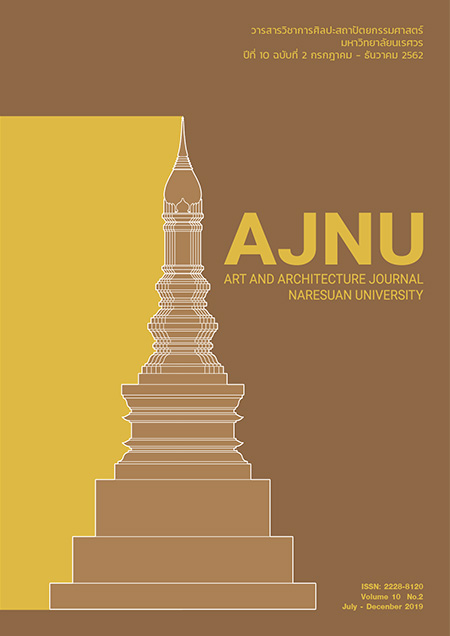Developing Costumes for Islamic Women According to the Trend of Fashion Design in 2014
Main Article Content
Abstract
The objectives of this study are to; 1) explore designing methods of costumes for Islamic women according to the trend of fashion design in 2014, and 2) to develop three fabric patterns and three wearable costumes for Islamic women. The study employed experimental development as a methodology. Knowledge and experiences of fashion design and textile were applied in the designing fabric patterns and costumes. A purposive sampling technique was employed to gain ten clothing producers. Data were gained through interviews with the producers and customers. Previous literature and textbooks about costumes of Islamic women were reviewed for descriptive data analysis. In the later phase, the fabric patterns and costumes were designed according to clothing design procedures. The research was conducted at Kae Batik Community Enterprise Group in Sateng, Meuang, Yala. The results revealed that Islamic women dressed properly conforming to Islamic principles. They covered most parts of their body with a unique hijab on their heads. This reflected their strong faith in God. However, some modern Islamic women preferred hijabs with artistic fabric patterns and avoided patterns of animals or other creatures. The most common patterns included vines, leaves, or flowers. Moreover, three fabric patterns, namely Watercolor Florals, Heirloom Modern, and Weathered Florals were created. They all served the producers’ needs. In addition to this, three prototype costumes were sown including a causal ware, a business ware, and a party ware. The patterns and prototypes were influenced by the fashion trends in 2014, which Islamic women could wear in their daily life.
Article Details
References
นฤมล ปิ่นวิศุทธิ์. (2555). สร้างสรรค์งานศิลปะ บนผืนผ้า (มัดย้อม-บาติก). กรุงเทพฯ : สำนักพิมพ์โอเดียนสโตร์.
พัดชา (เสนาณรงค์) อุทิศวรรณกุล. (2550). เอกสารประกอบการสอน Fashion Illustration. กรุงเทพฯ : คณะศิลปกรรม
ศาสตร์ จุฬาลงกรณ์มหาวิทยาลัย.
ยุพินศรี สายทอง. (2553). ปาเต๊ะ : เทคนิคการออกแบบลวดลายบนสิ่งทอ. กรุงเทพฯ : สำนักพิมพ์โอเดียนสโตร์.
สาคร คันธโชติ. (2528). การออกแบบและพัฒนาผลิตภัณฑ์. กรุงเทพฯ : สำนักพิมพ์โอเดียนสโตร์.
เสาวนีย์ จิตต์หมวด. (2531). กลุ่มชาติพันธุ์ : ชาวไทยมุสลิม. (พิมพ์ครั้งที่ 1). กรุงเทพฯ : กองทุนสง่ารุจิระอัมพร.
ดารีน. วันฮิญาบโลก. นิตยาสารวาไรตี้ สื่อสัมพันธ์ของครอบครัวมุสลิม นิสาวาไรตี้. 14 (137).
วิกิพีเดีย สารานุกรมเสรี. ฮิญาบ. สืบค้นเมื่อ 29 พฤษภาคม 2556, จาก https://th.wikipedia.org/wiki/ฮิญาบ.
วิกิพีเดีย สารานุกรมเสรี. (28 ตุลาคม 2557). แฟชั่น. สืบค้นเมื่อ 15 มีนาคม 2559 จาก https://th.wikipedia.org/wiki/
แฟชั่น.
สุชาติ เศรษฐมาลินี. บทบาทมุสลิมะฮ์ในโลกที่เปลี่ยนแปลงและสังคมที่เปลี่ยนไป. บทความเรื่องสถาบันศาสนาวัฒนธรรมและ
สันติภาพมหาวิทยาลัยพายัพเชียงใหม่. สืบค้นเมื่อ 15 ธันวาคม 2556, จาก
www.islamhouse.muslimthaipost.com
อับดุลฆอนี บุญมาเลิศ.(2558).การแต่งกายของมุสลิมะฮ์. สืบค้นเมื่อ 20เมษายน 2561จากwww.islammore.com/view/940
อลิสา หะสาเมาะ. (2552). อัตลักษณ์ของชุมชนมุสลิมในตำบลรือเสาะออก : ภาคใต้ของประเทศไทย. วารสารวิชาการคณะ
มนุษยศาสตร์และสังคมศาสตร์. 5(2), 203-230.
ฮัยยาตี ตวนบอส และคณะ ฮิญาบ : วิธีการสร้างลวดลายผ้าคลุมผมแบบสมัยนิยม กรณีศึกษา กลุ่มสตรี ชุมชนบ้านบูเกะกือจิ
ตำบลบูกิต อำเภอเจาะไอร้อง จังหวัดนราธิวาส. มหาวิทยาลัยราชภัฏ, นครศรีธรรมราช.

